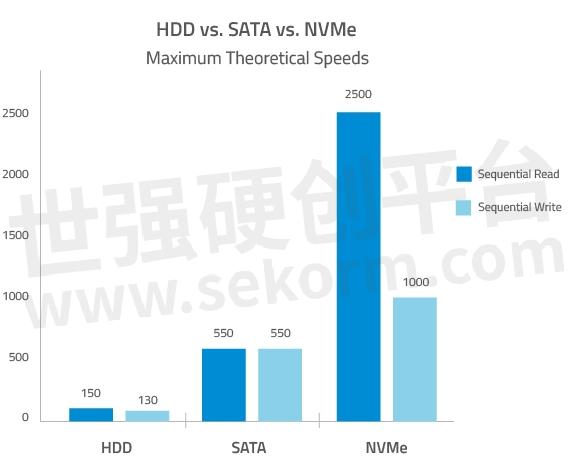What is NVMe SSD and What are the Benefits?

What is NVMe?
NVM Express®, also known as NVMe™, is an interface specification optimized for NAND flash and next-generation solid state storage technologies. This interface is defined to efficiently support the needs of enterprise and client systems utilizing PCI Express® (PCIe®) solid state drives.

Why do we need another interface specification?
Over the years, CPU and DRAM speeds have increased, but mechanical drives and interfaces used to connect them have not kept up. The NVM Express Work Group, made up of leading technology manufacturers, developed NVMe to narrow the growing gap between fast DRAM and slow storage.
What is PCIe and why is NVMe optimized for PCIe-based SSDs?
PCIe, which stands for Peripheral Component Interconnect Express and also known as PCI Express, is an I/O interconnect interface that was designed as a high-speed replacement for aging standards like PCI and AGP. PCIe typically operates as a motherboard interconnect that links motherboard-mounted peripherals, such as graphics cards or wireless network cards. Although it is more of an interconnect interface than a storage interface, PCIe's excellent features for scalability, latency and performance make it a compelling interface choice for storage applications and solid state storage.
What are the benefits of the NVMe specification?
NVMe delivers faster access and consumes less power, thus reducing total cost of ownership (TCO) for enterprises and extending battery life for mobile clients. Compared with other interfaces designed for mechanical storage devices, NVMe reduces latency, and delivers higher Input/Output per Second (IOPS). NVMe also offers performance across multiple cores for quick access to critical data, scalability for current and future performance, and support for standard security protocols.
How does NVMe compare with other storage interfaces?
Seria ATA (SATA™), with its 3rd generation 6 Gb/s bandwidth, is currently the most widely used interface for hard disk drives (HDDs). Advanced Host Controller Interface (AHCI), the technical standard that specifies the operation of SATA host bus adapters, was designed to connect the CPU/memory subsystem with much slower rotating media-based storage. This renders the AHCI inefficient for the much faster SSDs, which behave more like DRAM than spinning media.

In random workloads, NVMe delivers 2X the performance of SAS 12 Gb/s, and 4-6X of SATA 6 Gb/s. For sequential workloads, NVMe delivers 2X the performance of SAS 12 Gb/s, and 4X of SATA 6 Gb/s.
What are the differences between AHCI and NVMe?
AHCI, although compatible with SSDs, was designed for hard drives. AHCI was developed to connect the CPU/Memory subsystem with rotating storage media subsystem. The table below summarizes the differences between NVMe and AHCI device interfaces.

Table 1. Technical differences between AHCI and NVMe. (Source: SATA-IO)
In what operating environments is NVMe supported?
NVMe is supported in the following environments:

What businesses will benefit most from NVMe?
NVMe was designed for both enterprise and client applications needing acceleration in critical data. Data centers will benefit greatly, as NVMe eliminates bottlenecks and provides capabilities to meet very demanding and time-sensitive requirements of cloud, Internet portal data centers, and other high-performance computing environments. Aside from enterprises and data centers, NVMe offers vast potentials in gaming, entertainment, and next-generation automobile applications.
What NVMe solutions are available from ATP Electronics?
ATP M.2 2280 NVMe SSDs are designed for a PCIe 3.0 x4 interface and comply with NVMe 1.2 specifications. Along with up to 1 TB memory capacity, sequential read speed of up to 2,540 MB/s, and sequential write speeds up to 1,100 MB/s, ATP M.2 NVMe SSDs exceed the SATA interface bandwidth 2x-3x, eliminate bottlenecks, and deliver a dramatic performance boost over AHCI standards. ATP M.2 2280 NVMe SSDs integrate 3D NAND MLC technology, enabling higher memory capacity, lower cost per bit, and increased longevity.
- +1 Like
- Add to Favorites
Recommend
- M.2 2280 PSLC NVMe SSDs Break 3D TLC Limits wth 2000 MB/s Sustained Sequential Write Performance
- NVMe SSD Thermal Management: What We Have Learned from Marathons
- PCIe NVMe SSDs with High Endurance by 3D NAND Technology, Providing End-to-end Data Path Protection
- PCIe vs. NVMe: Are They the Same?
- The SP2800 PCIe NVMe M.2 2280 SSDs wth 3D NAND Technology and High Endurance
- ATP NVMe Solutions Built for the Fast Lane, Sequential Read Speed of up to 2,540 MB/s, and Sequential Write Speeds up 1,100 MB/s
- SMART CP3000 PCIe NVMe M.2 2280 SSDs Feature a PCIe Gen4 X4 Interface and are Compliant to NVMe 1.4 Specification
- ATP Launches Its Tiniest PCIe Gen3 x4 NVMe™ SSDs in M.2 Type 1620 HSBGA Package
This document is provided by Sekorm Platform for VIP exclusive service. The copyright is owned by Sekorm. Without authorization, any medias, websites or individual are not allowed to reprint. When authorizing the reprint, the link of www.sekorm.com must be indicated.


















































































































































































































































































































































































































































































































































































































































































































































































































































































































































